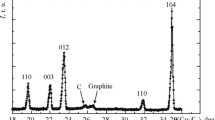Abstract
Metal-carbon-boron powder mixtures were hot pressed and the resulting specimens were studied by X-ray diffraction. It was found that regardless of the starting combination of the metal, carbon, or boron powders, a metal boride phase was always the major component in these samples. In the absence of carbon the boride phase formed on hot pressing depended only on the amount of boron present. Two new phases of the system Ti-B were found. They are TUB and Ti2B5. The existence of a controversial face-centered cubic phase of formula TiB was confirmed. Electrical resistivities were measured for various boride phases. It was found that the diborides are generally better conductors than the monoborides of the same metal.
Similar content being viewed by others
References
F. W. Glaser: Powder Metallurgy Bull. (1951) 6, 1, pp. 51–54.
R. Steinitz: Powder Metallurgy Bull. (1951) 6, 1, pp. 54–56.
J. A. Nelson, T. A. Willmore, and R. C. Womeldorph: Refractory Bodies Composed of Boron and Titanium Carbides Bonded with Metals. Presented at the Ninety-Ninth Meeting of the Electrochemical Society, Washington, D. C. April 8–12, 1951.
E. R. Honak: Ueber Hochschmelzende Boride der Uebergangsmetalle. Thesis, Techn. Hochschule Graz. 1951.
L. Andrieux: Annales de Chimie (1929) 12, p. 423.
J. T. Norton, H. Blumenthal, and S. J. Sindeband: Structure of Diborides of Titanium, Zirconium, Columbium, Tantalum and Vanadium. Trans. AIME (1949) 185, pp. 749–751; Journal of Metals (October 1949).
H. M. Greenhouse, O. E. Accountius, and H. H. Sisler: Journal A.C.S. (1951) 73, p. 5086.
P. Ehrlich: Angew. Chem. (1947) 59, p. 163; Ztsch. anorg. allgem. Chem. (1949) No. 1, p. 259.
L. H. Andersson and R. Kiessling: Binary Systems of Boron with Chromium, Columbium, Nickel and Thorium, etc. Acta Chem. Scand. (1950) 4, p. 160.
B. Post and F. W. Glaser: Crystal Structure of ZrB12. To be published in Trans. AIME, Journal of Metals.
H. Blumenthal: To be published in Journal A.C.S.
R. Kiessling: The Binary System Zirconium-Boron. Acta Chem. Scand. (1949) 3.
R. Kiessling: Borides of Tantalum. Acta Chem. Scand. (1949) 3, pp. 605–615.
L. Brewer, D. L. Sawyer, D. H. Templeton, and C. H. Dauben: Journal Amer. Ceramic Soc. (1951) 34, No. 6.
R. Kiessling: Crystal Structures of Tungsten and Molybdenum Borides. Acta. Chem. Scand. (1947) 1, pp. 893–916.
Metals Handbook. (1951) A.S.M. Cleveland.
C. Agte and K. Moers: Ztsch. anorg. allgem. Chem. (1931) 198.
R. Steinitz: The System Mo-B. Journal of Metals (February 1952) p. 148.
B. Post and F. W. Glaser: Unpublished.
Author information
Authors and Affiliations
Additional information
Discussion on this paper, TP 3281 E, may be sent, 2 copies, to AIME by June 1, 1952. Manuscript, Aug. 1, 1951; revised, Jan. 22, 1952. New York Meeting, February 1952.
Rights and permissions
About this article
Cite this article
Glaser, F.W. Contribution to the Meta I-Carbon-Boron Systems. JOM 4, 391–396 (1952). https://doi.org/10.1007/BF03397703
Published:
Issue Date:
DOI: https://doi.org/10.1007/BF03397703




